Prenote: this is a rather detailed technical description of this IFR trip.
The idea of this trip was born long time ago, but postponed many times. At this year’s new year party, the idea was relived when my father-in-law, his brother-in-law and me discussed again to fly to Lorient in south Brittany, France for a male-only weekend in uncle’s historic house on the beach. We had selected the long weekend of pentecost so we could spend two nights out. For this occasion I had rented the loyal Piper Warrior III OO-JAB from Propeller in Kortrijk, Belgium: a well-equipped but rather underpowered 160HP machine. Take into account the weight of three well-settled adults, I expected heavy weight & balance calculations.
Flight Preparation
Planning this trip was an interesting challenge and it took a couple of iterations to get it right. Allow me to explore the boundary conditions here with you.
First of all, my flying companions disliked the idea of spending four hours in an airplane without lavatory functions on board. This implied that I had to plan a bladder stop on the routing from Kortrijk (EBKT) to Lorient (LFRH).
The second condition was to find a suitable IFR intermediate airfield in between Kortrijk and Lorient. Luckily, France is well equipped and with most IFR airfields offering GNSS RNAV GPS approaches now, this condition was not very restrictive.
The third condition was weight: with three adults and their respective, albeit restricted, luggage on board, together with my flying gear, our gross weight restricted fuel to maximum 40 gallons out of the 48 gallons.
This lead immediately to the fourth condition: 40 gallons max fuel certainly implied a needed fuel stop, particularly when foreseeing two IFR alternates for every destination. This Piper only cruises at 110 KTAS, consuming about 8,5 GPH when properly leaned.
Fifth condition was of my own making: I wanted to refuel at a location with a Total fuel station as I do have such card and I find it very useful and convenient.
The sixth condition was the most surprising and insidious one. Let me explain: as we had chosen Lorient Lann-Bihoué (LFRH) as our destination airport for its proximity to the beach house, we had to ask permission to the military commander of that French Navy airfield to land there. More about that process later, but the restriction here was that we could not buy Avgas fuel on that airport. So I opted to reduce the number of refueling events from 4 to 3: I would fuel 40G at the start in Kortrijk, top up to 40G on the intermediate stop with the Total card, I would not fuel in Lorient, upon returning fuel again on the intermediate stop with the card, and fly back to Kortrijk. This implied that the second and third leg of my trip had to be done on 40G of fuel together, including the IFR and alternate reserves required for both trips. This condition put my intermediate pretty close to the Lorient destination, bringing the bladder condition under pressure.
As explained, it took a couple of iterations of planning. First I would do the stop in Le Havre (LFOH), but that breached the sixth condition on doing two legs with 40G fuel only. So I looked to suitable airports closer to Lorient. Too close would put our bladders under pressure. Too far and we would start taking fuel risks.
Finally I settled on Laval (LFOV) as the fuel stop:
- Total fuel station
- A NDB and a RNAV approach, but no ILS approach, so I selected Rennes (LFRN) and Le Mans (LFRM) as alternates
- Close enough to Lorient (about 1h10 minutes still to go) allowing a forth and back to Lorient on 40G of fuel including IFR and alternate reserves
- Not too far from Kortrijk to not put bladders under pressure
I had the free Autorouter working out the following routes:
- EBKT LL DCT NAVAN DCT VAMOP DCT CMB R50 DPE H20 LGL A5 DIDAK DCT TABIL LFOV at FL080, alternates Rennes and Le Mans
- LFOV TABIL DCT LAGAB DCT LENSU LFRH at FL060, alternates Guisscriff and Quimper
- LFRH LENSU DCT LAGAB DCT TABIL LFOV at FL070, alternates Rennes and Le Mans
- LFOV TABIL DCT PEPAL A361 LGL H20 DPE R50 OBIVA R50 CMB DCT VAMOP DCT NAVAN DCT LL EBKT at FL090, alternates Lille and Ostend
Note that these routes are optimized for short distance while they still comply with the Eurocontrol validation system. I printed out all Jepp charts of all IFR airports surrounding the route and alternates with 25 NM, and then some more.
As explained, Lorient Lann-Bihoué (LFRH) is a military airport used mainly by the French marine. I contacted the military commander there via email with all details about my flight and my passengers, and got a quick reply. Before granting me permission, I had to obtain a parking: either on the civil terminal or with the Lorient aeroclub. I had flown there on a training flight with the aeroclub and requested them for a parking spot while referencing my previous flight, twelve years ago. They gave me permission to park and with that I obtained permission to land from the military. This process took two days of emailing. Jeppesen does not provide the charts for Lorient, so I got them from the free SIA France website.
Next step was monitoring the weather. My favourite tools in order from long term to short term are
- Meteo France for the long term forecast
- GRAMET
- http://euro.wx.propilots.net/ for the aviation weather
- Belgocontrol
- A iPhone app called “Takeoff” for METARs and TAFs
As it usually does, the weather forecast did change a couple of times, and while initially I thought that the return flight would be a limiting one weatherwise, it became apparent that the going legs would be most challenging. Also, weather forecasts feel more threatening than the actual flight with notable exceptions.
NOTAMs did not bring up anything notable. I did obtain them from two sources as previously I have had problems with the completeness of the NOTAMs provided through Rocketroute, a problem I logged with that provider and who adequately provided a solution.
The weight and balance, as indicated before, with three sizeable adults on board, was a matter of restricting fuel to 40G. I must admit that this is not my Standard Operating Procedure. I normally always take off with full tanks in order to reduce the fuel incertainty risk. So this time, I had to adapt and learn. The biggest learning point was: how you know when you had 40G in your tanks? The Piper with its Avidyne system does have a fuel totalizing system on board, but its setting was only as reliable as the last renter pilot had used it. Also, there was a yet-to-explain discrepancy between the total indicated fuel and the fuel indicated present in each tank. The exercise turned out to be simpler: fill up until the tabs (17G) and add 3G more in each tank. This only works, however, when fuel is below the tabs to start with.
All flightplans were managed and filed via Rocketroute.
First leg: Kortrijk – Laval
Plan: EBKT LL DCT NAVAN DCT VAMOP DCT CMB R50 DPE H20 LGL A5 DIDAK DCT TABIL LFOV at FL080, alternates Rennes and Le Mans
That morning we checked and loaded up the airplane. I keep stuff that I need within hand reach on the rear seat (POH, flight bag, backup gear (GPS, transceiver), water, camera), and the mundane luggage in the rear baggage compartment.
The fueling was performed as described above.
Kortrijk Information, a AFIS only, provided me with the clearance obtained from Lille: direct LL, climb 4000ft initially and contact Lille Approach. We took off from runway 24, and I immediately noticed that we actually were at max gross weight with an aft balance. The airplane did not climb as swiftly as I was used. In fact, it struggled to get up at the filed altitude of FL080 with a vertical climb speed below 500 fpm.
We switched to Lille Approach, and they gave us immediately a nice Direct to Dieppe VOR, cutting off the planned and filed dogleg via Cambrai VOR. Dieppe VOR is still under (or very nearly so) Lille’s controlled airspace, so she did see all the way that there wasn’t any traffic on that altitude (as there never is !). I had chosen FL080 to be below the oxygen limit (no chance to fiddle with oxygen with the two non-experienced passengers), and above the clouddeck. However, the clouddeck remained persistent. We were constantly in and out clouds and when passing FL070, the outside air temperature dropped to around 1°C. In order to avoid any possible ice, I asked and obtained a descent back to FL060. It was a weird reconfiguration from a long and slow climb regime to an immediate descent at max gross weight. I took a mental note of how unusual I found that.
We cruised happily along to Dieppe. We were switched to Paris Control, a frequency with lots of traffic of airliners descending towards Charles de Gaulle airport. From there direct to l’Aigle VOR. I requested the actual weather of Laval from those controllers, but could not obtain it after a long wait. They were apparently telephoning Laval AFIS, which was unmanned. This felt outdated as you can get the AUTO METAR asap via a little Google or any modern online weather tool. So I asked the Rennes weather instead, which they provided in between all their big iron airline communication. I can never complain about the attitude of French controllers: always helpful to us small airplanes !
The weather forecast for Rennes called for clouds BKN at 900ft, giving me plenty of margin on the nearby GNSS approach into Laval with its 340ft AGL minimums. After l’Aigle VOR, I was switched to Rennes approach, a much quieter frequency. The only other souls in that airspace were GA pilots, mostly all VFR. It striked me again how the English pilots keep rambling their completely superfluous radio routines, including requests for “Basic Service”. Does their training not tell them that “Basic Service” is a purely UK affair, and that in the rest of the world, you ask for “flight information” ? The absolutely weirdest conversation I picked up was a clearly English pilot who spoke decent French but with an strong English accent, and a French controller replying him in decent English: this absurd convo went on and on and felt unsafe to me: it was as if both wanted to prove their right to the other one. I wonder what the rule is here: who choses and decides on what language to use? My rule is: I always use English except where French is mandatory, but I follow through on the French convos for situational awareness.
After l’Aigle they gave me a direct to LA, which is a NDB used on the NDB approach into Laval. This was my cue to request the GNSS approach at Laval, and like experienced before in France, this felt as a surprise to ATC. I think they are still getting used to GNSS approaches. It took them five minutes to change their ‘direct to LA’ into a ‘direct to ARNAV’, the IAF of that GNSS RNAV Rwy 32 approach into Laval.
ATC always asks us to trigger them for descent in this empty airspace, so my small mental calculation for the TOD timing goes as follows: how much feet to descent till the approach altitude (about 2000ft in Laval)? From my cruising level of FL060, that’s about 4000ft. I want to descent at 500fpm, so that will take 8 minutes. I want to start descent 8 minutes before the IAF.
Upon that time, I requested and obtained clearance to descend. They passed me their telephone number to close the flightplan on the ground. Descent checklist and there we go. Into the clouds at around 3000ft, and gently following the course that the GPS plots out: these GNSS approaches are very convenient. I popped out at around 1000ft MSL. I tried to switch on PCL for dramatic effect, but it didn’t work in daylight. Other traffic on the A/A frequency indicated rwy 32 in use, so I merged in and landed.
A small backtrack and a taxi to the fuel pump. I closed the flightplan via phone while manipulating the Total machine with my card. We refueled back to 40G using the tabs+3G method. We walked out of the perimeter to find bladder relief, and as in many smaller airports in France you need to ensure that you find the code to get back in. Also here in Laval, there was a secret code, placarded only to arriving pilots indicating how to get back in.
Second leg: Laval – Lorient
Plan: LFOV TABIL DCT LAGAB DCT LENSU LFRH at FL060, alternates Guisscriff and Quimper
We got back, and we departed VFR and heavy again from rwy 32 again inbound TABIL waypoint. We ran ahead of time due to the shortcuts we had received from ATC and a faster stop than foreseen in Laval. I remained below the clouddeck and contacted Rennes Approach again. They gave me a direct to Lorient straight away, cleared me to FL060 and I became IFR again.
Above the clouddeck again, it became apparent that the route was littered with growing cumuli patches. Temperature started to rise and the further we proceeded, the fatter the cumuli became. I saw a big one, and requested to route towards left around it, taking me more to the south. It was a magnificent sight to fly close to young building cumuli ! At the end I tunneled through the build-ups.
Irroise Control recleared us to KERAK, the IAF for the ILS approach to runway 25 in Lorient. I obtained the ATIS of Lorient. Shortly after, they passed me to the military controller of Lorient Approach who cleared my descent and later the ILS approach. The guy warned me about arresting cables 150m after the threshold.
On the ILS, Lorient Tower warned me again about the cables. They were made visible by means of round yellow indicators. I landed after the cables on the spot marked by black rubber left behind on the runway by many military jets: this was the best way to avoid those darn arresting cables.
On the ground we taxied to the aeroclub where everyone was out for lunch. So we parked on what seemed to be the best spot: under a tree halfway onto grass, and I loaned some laying-around wheelblocks from the club. The apron of the club was neat, but packed with airplanes. This outlet has definitely done well over the past 12 years !
In Brittany
I had rented a car from Europcar who had provided me with good service before in France. This time they had left behind the keys and the paperwork at the aeroclub, so we found it fast: nice service! We were soon on our way to lunch and 45 minutes ahead of time ! Pizzas were ordered before 14h, and we had left Belgium at 9h15: my two passengers were duly impressed and I did not receive bladder complaints!
We spend a lovely weekend with good food and wine, at a fantastic location full of nice memories for the three of us. I did check the weather every now and then, but it looked OK although I saw that a cold front was planned to pass by during the night before our flight back to Belgium.
Third leg: Lorient – Laval
Plan: LFRH LENSU DCT LAGAB DCT TABIL LFOV at FL070, alternates Rennes and Le Mans
Soon we headed back to the airport. I simply dropped the key in the Europcar’s mailbox and were granted access again to the airfield through the aeroclub. Our blue Piper was loyally waiting for us with enough fuel on board to make it back to Laval. I asked for parking fees, and the aeroclub manager laughed and gave me the zero euro sign!
It was busy at the club. They called for me to Lorient ATC and as we were early, I had to refile the flightplan. That was done easily through Rocketroute. I checked the plane, and were soon taxiing. A aeroclub airplane behind us was very impatient. They even managed to jump ahead of us when there was confusing if I was on the Tower frequency already or not (I was!). We took some delay due to traffic but we were in a relaxed mood.
Take-off from the wide runway 25. I had requested to remain VFR for a scenic overflight of the house we had stayed in. Once passed that, they cleared me to LENSU towards FL070. In the confusion at take-off I had forgotten to switch on the transponder, so the controller pointed it out and I corrected it quickly.
After LENSU, Irroise Control gave me a direct LAGAB, and Rennes Approach did the same as two days before: first direct LA, and when I asked for the GNSS approach, they corrected the clearance to direct OTLOV, the western IAF for the same GNSS RNAV rwy 32 approach. They also passed me the telephone number to close the flightplan.
We dove inside the clouddeck left behind by the cold front during the night and popped out on the approach at around 1000ft MSL.
On the ground, we knew the drill and we made a turn-around that would make Ryanair jealous.
Fourth leg: Laval – Kortrijk
Plan: LFOV TABIL DCT PEPAL A361 LGL H20 DPE R50 OBIVA R50 CMB DCT VAMOP DCT NAVAN DCT LL EBKT at FL090, alternates Lille and Ostend
We took off again, and headed VFR direct l’Aigle (LGL) VOR and contacted Rennes Approach again. They cleared me IFR to LGL climbing FL090. They pointed out that I had forgotten to call them to close the flightplan … so far for our speedy turn-around, but I was still within the grace period.
At first we stayed at FL070, but the clouddeck, containing left behind cumuli from the cold front, raised again so we requested FL090 after a while. After LGL we received a nice ‘direct ABB’, followed by a ‘direct LEQ’ very near to our destination in Belgium. The flight was relaxed and the cold front disappeared to the east so the weather could clear out.
Wind was from the west, creating either a small headwind or a small tailwind during the flight. Before Lille, we descended and were passed to Kortrijk Information. I requested a visual approach to runway 24. There was a strong 10 knots crosswind, so I practiced my wing-low crosswind landing technique.
Behind us there was a C177 Cardinal landing without crosswind technique. He bumped, jumped 1,5m back into the air and still somehow managed to land without creating problems. Crazy …
It was a very nice trip, with multiple learning points and plenty of cloud practise. My two companions truely enjoyed …and that’s what we do it for, not?


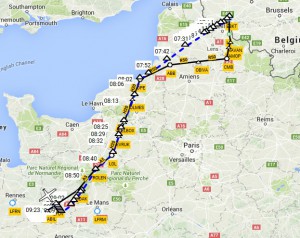
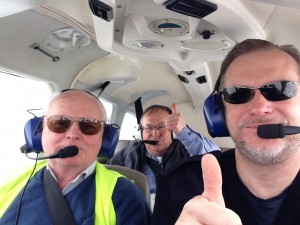
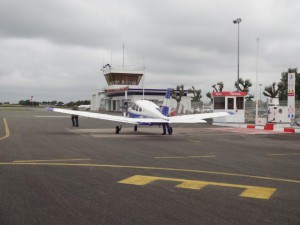
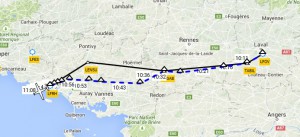
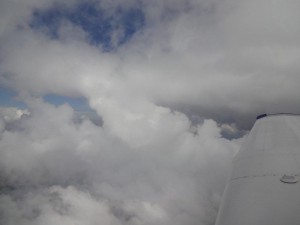
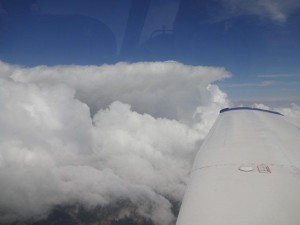
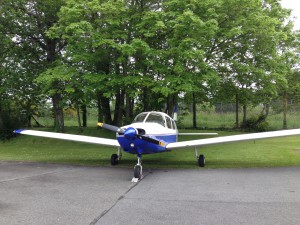

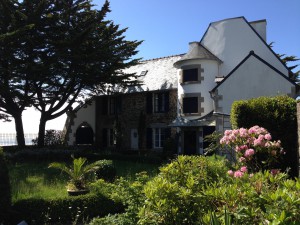
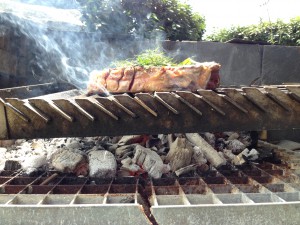
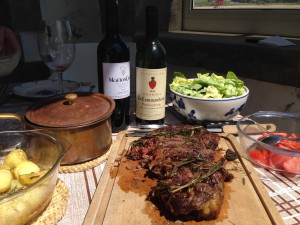

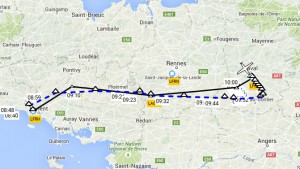
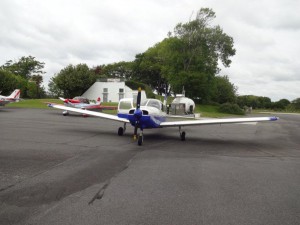
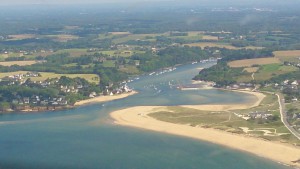
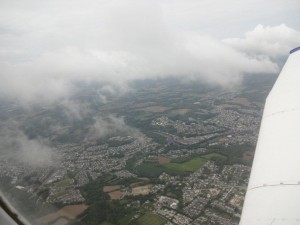
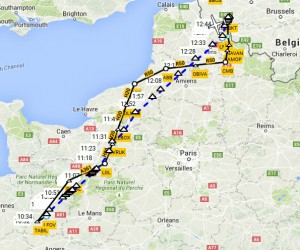
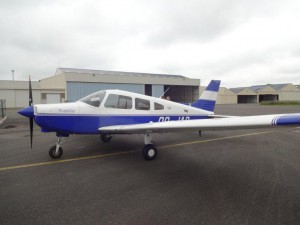
Great write-up. Many thanks, Peter, Dubai